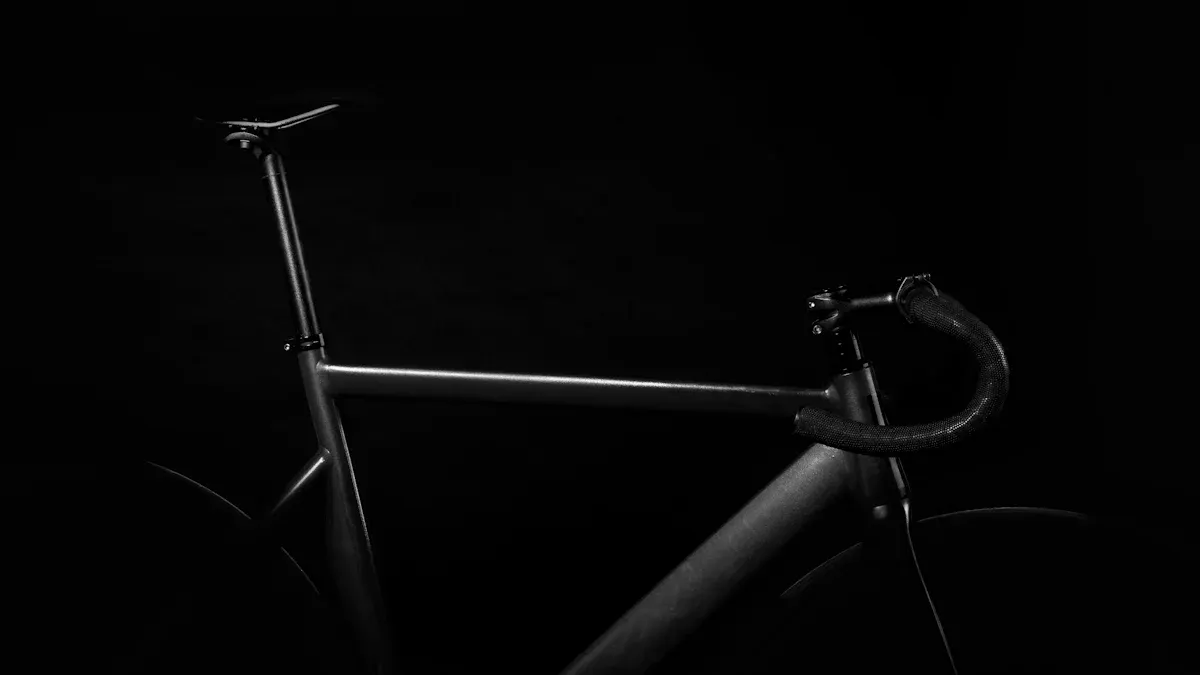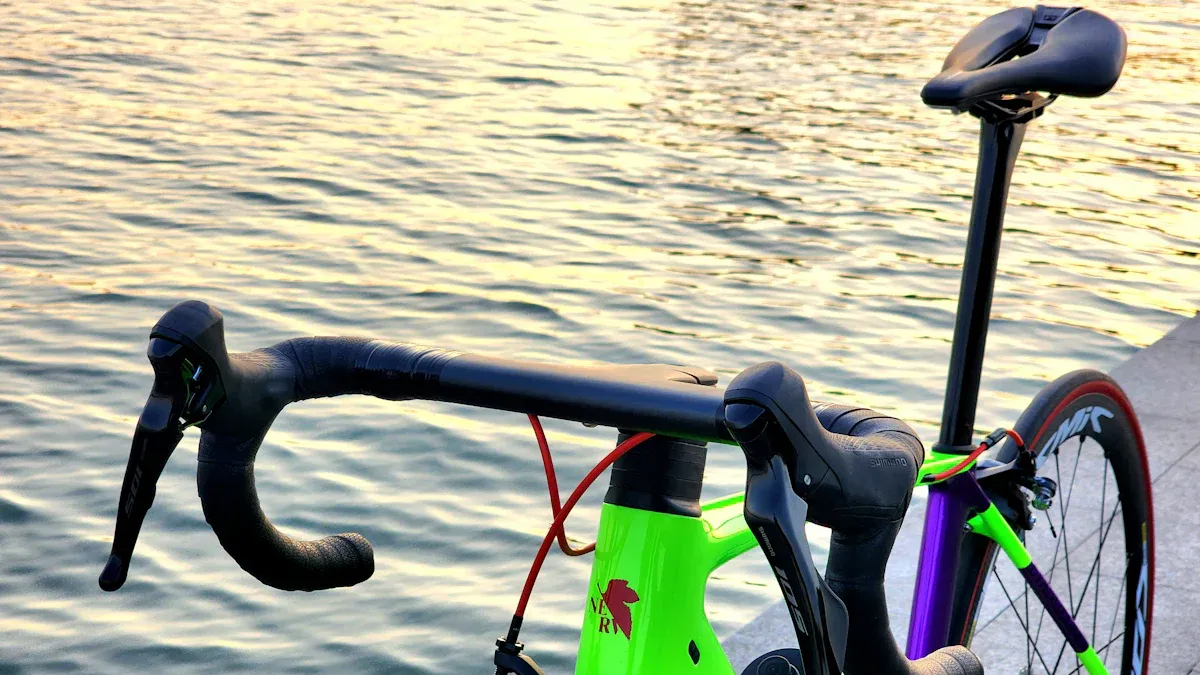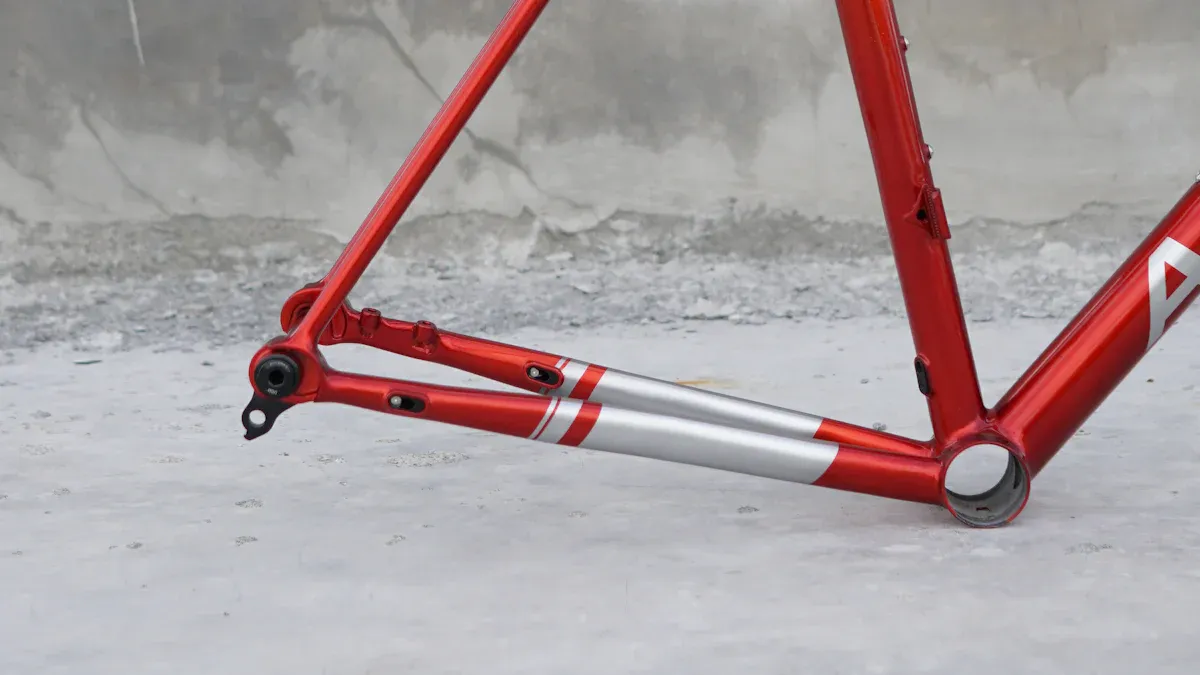
Finding the right fit for your custom frame road bike is very important. It affects how well you perform and how comfortable you feel. A bike that fits well helps you avoid problems, like back pain or knee pain, which can happen from bad sizing. Important things to think about include frame shape, which changes how the bike handles, and materials that affect how it rides. For example, a steeper seat tube angle can help you pedal better. The choice of material, like aluminum or carbon fiber, helps balance weight and stiffness. Focusing on these parts makes sure you have a comfortable and smooth ride.
Key Takeaways
Frame shape is very important. It affects how comfortable you feel, how well you perform, and how you handle the bike. Pick the right angles for a smoother ride.
Choose the right frame material. Steel, aluminum, titanium, and carbon fiber each have special benefits that change how the bike rides.
Look closely at the parts. The right size handlebars, seat posts, and headsets make riding more comfortable and give you better control.
Getting the right measurements is important. Measure your inseam, torso, and arm length to find the best bike size for you.
Think about getting a professional bike fit. It helps set up your bike, makes you more comfortable, and improves your cycling experience.
Frame Geometry

Importance of Geometry
Geometry is very important for your custom frame road bike. It affects how well the bike fits you and how it rides on the road. The right frame geometry can make your ride more comfortable and efficient. Here’s why it matters:
Performance: Good geometry helps you keep a good riding position. This can help you pedal better and go faster.
Comfort: The right angles and sizes can lessen strain on your body. This lets you ride longer without feeling pain.
Handling: Different geometries change how your bike steers. A bike with a steeper head tube angle feels quicker, while a slacker angle gives more stability.
To show how frame geometry matters, look at this table that highlights key points:
Aspect | Description |
|---|---|
Head Tube Angle | A steeper angle (e.g., 73°) allows for quick steering, great for racing; a slacker angle (e.g., 65°) gives stability. |
Seat Tube Angle | A steeper angle (e.g., 74-75°) helps with power; a slacker angle is more comfortable. |
Wheelbase | A longer wheelbase makes the bike stable; a shorter one makes it easier to turn. |
Stack & Reach | A higher stack gives more comfort; a longer reach makes for a more aggressive position. |
Key Measurements
Knowing the key measurements of frame geometry is key for the perfect fit. Here are some important ones to think about:
Effective Top Tube Length (ETT): This is the distance from the top tube to the seat tube. It affects your reach and comfort. Focus on ETT instead of just frame sizes, as different brands have different shapes.
Seat Tube Angle (STA): Research shows that seat tube angles between 72° and 76° are best for racing. A steeper STA can help you ride better and feel good when switching to running after biking.
Stack and Reach: These measurements help you know how high and far you need to stretch while riding. Here’s a quick table for stack and reach based on bike sizes:
Size | Stack | Reach |
|---|---|---|
49 | 528 | 378 |
52 | 547 | 379 |
54 | 564 | 380 |
56 | 590 | 387 |
58 | 622 | 392 |
61 | 643 | 398 |
64 | 657 | 409 |
By looking at these measurements, you can make sure your custom frame road bike fits you well. This will improve both your comfort and performance on the road.
Frame Materials

Common Materials
When you build a custom bike, the frame material is very important. It affects how your bike rides and feels on the road. Here are some common materials to think about:
Steel: Steel is strong and can flex. It gives a lively feel. It’s easy to fix and has been used in bike design for a long time.
Aluminum: Aluminum is 12% stiffer and 20% lighter than steel. It doesn’t rust and absorbs bumps quickly, making your ride fast. But it can feel rough on bumpy roads.
Titanium: Titanium is strong and light. It doesn’t rust and is good for bigger riders.
Carbon Fiber: Carbon fiber was made for aerospace. It is very strong for its weight. It’s light and absorbs vibrations well, but it can cost a lot.
Impact on Ride Quality
The material you pick really changes how your ride feels. For example, aluminum frames can feel rougher than steel or titanium, which usually give a smoother ride. Carbon fiber is known for reducing vibrations, so racers like it.
“One of the roughest bikes I rode was a steel Eddy Merckx from the late ‘80s. Scott’s new Foil surprises me, giving a smooth ride even with its big aerodynamic tubes.”
When you think about costs, remember that custom frames can be expensive. Making them takes a lot of time. Good materials need skilled workers, which raises the price. But choosing the right frame material can improve your ride and make your bike last longer. Steel frames can be fixed and resist damage well, making them a smart choice.
Components for Custom Frame Road Bike
Importance of Components
When you make a custom bike, the parts are very important for a good fit. Each part changes how you ride and how comfy you feel. Here are some key parts to think about:
Handlebars and Stem: The right size helps you steer and stay comfy. If they are too high or low, you might hurt your back or shoulders.
Seat Post: Changing the seat post helps you adjust your riding position. This can stop discomfort on long rides.
Headset: The type of headset affects how you steer and control the bike. A good headset makes your bike feel more quick and responsive.
Remember, the right parts can make your ride better. They help you keep a good posture and feel less tired.
Customization Options
There are many ways to customize parts that can really improve your bike fit. Here are some options to think about:
Adjustable Handlebars: These can lessen bumps and make your ride more comfy. For example, the FSA NS VAS stem says it gives 47% less vibration, making your ride smoother.
Seatposts: You can pick different seatposts to match how you ride. The Cane Creek eeSilk seatpost has 20mm of travel, which is great for softening bumps on rough roads.
Drivetrain and Braking Systems: You can change your drivetrain with options like single speed or many gears. For brakes, you can choose between hydraulic disc brakes or caliper rim brakes. Here’s a quick overview:
Component Type | Options Available |
|---|---|
Drivetrain | Gears (1 or 2 derailleurs), single speed, belt drives |
Brakes | Disc brakes (hydraulic), caliper rim brakes, V-brakes |
Choosing the right wheelset is also very important. The size, rim type, and width all change how your bike performs. A taller rim makes it stiffer and better for speed, while the rim width should match your tire choice for the best handling.
By focusing on these parts, you can create a bike that fits you just right and makes your riding experience much better.
Getting the Right Size
Measuring Yourself
Getting the right size for your custom frame road bike starts with accurate measurements. You want to ensure that your bike fits you perfectly, enhancing both comfort and performance. Here’s how to measure yourself effectively:
Inseam: Stand barefoot against a wall with your feet about four inches apart. Use a straight edge between your legs to measure from the top of the edge to the floor.
Thigh: Kneel on the floor and repeat the inseam measurement process.
Torso: Stand against a wall and measure from the clavicular notch (the dip at the base of your neck) to the floor.
Arm Length: Measure from the acromion bone (the bony tip of your shoulder) to a pencil held at a 45-degree angle.
Shoulder Width: Measure across your back from one acromion bone to the other.
Height: Stand against a wall and measure your total height.
Feet: Measure from the wall to the edge of a straight edge or book placed against your toes.
These measurements will help you determine the correct frame size for your custom bike. Remember, getting the right frame size is crucial for a comfortable ride and efficient pedaling.
Test Riding Tips
Once you have your measurements, it’s time to hit the road and test ride your custom frame road bike. Here are some tips to ensure you get the most out of your test rides:
Knee Tracking: Pay attention to how your knees move while pedaling. They should track vertically. If they move diagonally, it might indicate a poor fit.
Riding Position: Adjust your riding position to relieve pressure on your wrists and lower back. A good fit should feel natural and comfortable.
Pedal Stroke: Focus on your pedal stroke. A flatter stroke is more efficient and reduces knee flexion, suggesting a proper fit.
When you test ride, look for these key indicators:
Comfort: The bike should feel like an extension of your body.
Pain-Free Riding: You should be able to ride without discomfort.
Efficiency: The bike should allow for smooth and efficient pedaling.
Consider getting a professional bike fit. A fitter can fine-tune your bike to match your body’s unique dimensions. They’ll assess your riding style and make adjustments to optimize your fit. Many cyclists find that a professional fitting enhances their riding experience significantly.
“I had a Velogicfit 3D bike fit and it was an amazing experience. I now feel a lot more confident, balanced, and comfortable on my bike.”
Choosing the right size and getting a professional fit can make all the difference in your cycling journey. So, take the time to measure yourself accurately and enjoy the benefits of a well-fitted custom bike.
Finding the right fit for your custom frame road bike is very important for a good ride. Here’s a quick summary of what you learned:
Frame Geometry: It decides how your bike feels and fits you.
Frame Materials: They change how smooth and comfy your ride is.
Components: The right parts improve your fit and how well you ride.
Getting the Right Size: Measuring correctly and test rides help with comfort.
Spending money on a bike that fits you well is worth it. Custom bikes are made for your body, giving you comfort and efficiency. They save you time and money by needing fewer changes. Also, a custom bike helps you ride better and enjoy your time on the road. So, take the next steps to find your perfect custom frame road bike and enjoy every ride!
FAQ
What is the best way to measure for a custom road bike?
To measure for a custom road bike, check your inseam, torso, arm length, and height. Use these numbers to find the right frame size and shape for you.
How often should I get my bike fitted?
You should think about a bike fitting when you change how you ride, feel discomfort, or get a new bike. Regular fittings help keep you comfortable and performing well.
Can I customize components on my road bike?
Yes! You can change parts like handlebars, seat posts, and wheels to improve your fit and riding experience. Adjusting these parts can really boost comfort and performance.
What are the benefits of a professional bike fit?
A professional bike fit makes sure your bike fits your body perfectly. It helps stop injuries, increases comfort, and makes your cycling more efficient.
How much does a custom road bike cost?
The price of a custom road bike can vary a lot based on materials, parts, and labor. Be ready to spend more for high-quality materials and skilled work, but the fit and performance are worth it.
See Also
Discover How to Find Your Perfect Bike Frame Fit
Use a Bike Frame Size Calculator to Get Your Fit
Measuring Your Bike Frame for Optimal Riding Comfort
